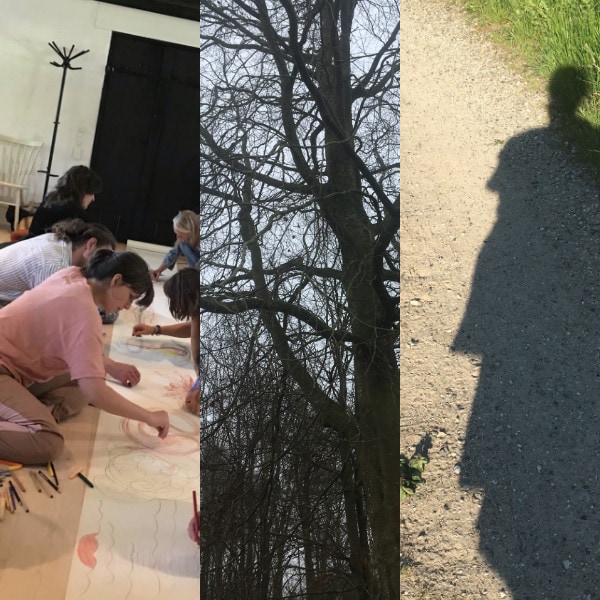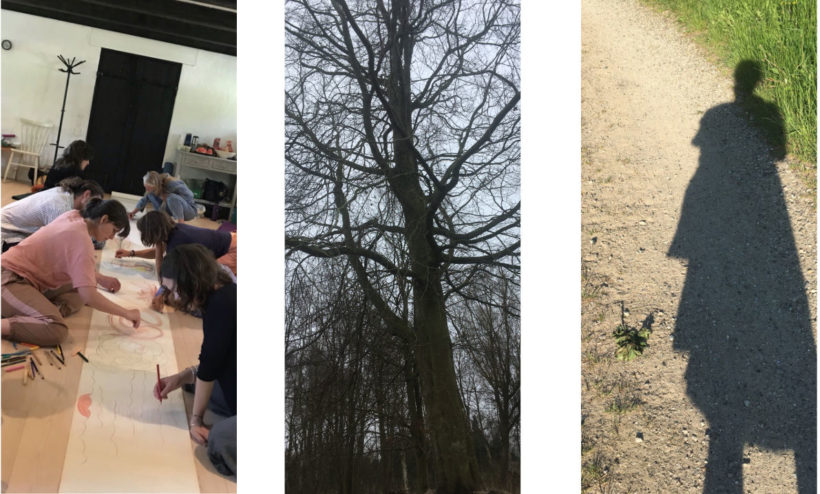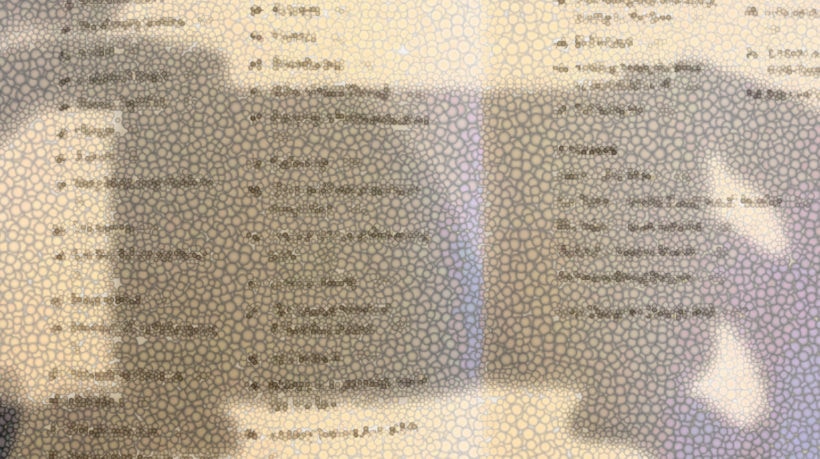While academic thinking increasingly shapes itself along the structure of the scientific journal article, compelling steadfast arguments that smoothly steer readers from question to conclusion (Grünfeld 2020), a growing volume of work pushes back; pushes for thinking, analysis and theory characterised by “openness, attunement, and responsivity” (Throop 2018), that “stays with the trouble” (Haraway 2016) and “acknowledge[s] the uncertainties of interpretations and knowledge-making” (Andersen and Høybye 2021). Rather than argumentative linearity, such work creates “zones of undecidability” (Badiou 2009, 45) – zones where theory stands forth “as a mode of thought that takes place (…) in the middle of attachments and threats, of what lingers and what jumps” (Stewart 2017, 196). But what does such thought and thinking entail in practical terms?
With this thematic thread, we suggest that this kind of theorising and thinking requires another body than the one traditionally trained for academia – a body that is more receptive, more sentient, more response-able. It is no secret that the notion of the body upon which we draw is Merleau-Pontyan. For Merleau-Ponty the body-subject was the zero-point of our engagement with the world (Merleau-Ponty [1945] 2012); it embodies our trajectory as historical subjects; frames our thinking through image schematas (Johnson 1990); reflects upon itself as a ‘thing’ in the world and becomes other to itself (Leder 1990). But we are here less concerned with the question of what a body is. Rather, inspired by Deleuze’s reading of Spinoza (1988), the question we are engaging is what a body might be able to do – and what kind of thinking that becomes with such body-doings.
With this thematic thread, we suggest that this kind of theorising and thinking requires another body than the one traditionally trained for academia – a body that is more receptive, more sentient, more response-able.
There is no standard body in the texts we feature here, only bodies in the midst of diverse doings; knitting, singing, crowing, imagining, walking on eggshells or dancing with sticks, moved by ghosts, a bug, maelstroms of blood or photosynthesis. These bodies did not at first or at all times feel fine in such doings; all academically trained, most of them anthropologically so, many found themselves cramped with embarrassment when asked or wishing themselves to be more sentient, receptive, response-able in their academic practices. Trying to sense affective responses to an academic article (cf. Schoeller and Thorgeirsdottir 2019), move with a concept (Dumit 2017) or experiment with attuning to other perspectives than human ones (Myers 2014), is indeed a risky endeavour within many academic communities – it makes you vulnerable to accusations of being unacademic, unscientific, too subjective; too much. No wonder then, that to think other thoughts, we need other kinds of training than those most commonly favour in academia; methodologies that take advantage of rather than shy away from the fact that all activities involve not only intellectual but also affective and bodily engagement (see e.g. Andersen and Høybye 2021; Ballestero & Winthereik 2021; Dumit 2017; Myers 2014; Schoeller & Thorgeirsdottir 2019). The specific methodologies we are interested in here all aim to train bodies for the kinds of thinking that can “defrost” (Mattingly 2019), “sensitize” (Latour 2014) and “enliven” (Guyer 2013) concepts; thinking that moves and flexes in response to the weights, wonders and worries of worlds beyond their own.
So, what are these methodologies? With the explicit aim of featuring work by people with varying degrees of academic experience and a willingness to experiment with the academic style and genre, the essays in the present thematic thread spring from three workshop-series, we have facilitated the past couple of years: a six-week course for MA anthropology students; a two-day workshop for Ph.D. students from art and design; and a three-day collaborative seminar for anthropologists trained in body-based methodologies. In addition, we have invited a contribution from Sigríður Þorgeirsdóttir, one of the initiators of the program, Training Embodied Critical Thinking – a training in which we ourselves have participated. This training has informed the design of parts of the workshop-series, as has also Berlant and Stewart’s writing format The Hundreds (2019). In all three workshop-series hundreds has served as a template for thinking the complexities, contradictions and questions to which the other bodily-affective methodologies gave rise.
Hundreds is text written in exact hundred-word sections and is based on concrete observations of the worlds of others as well as your own. The format compels you to pay careful attention to every single word; each word counts “one”, each “one” is a singularity, each gap between words potentially meaningful. Writing hundreds means cultivating, exploring and refining perception as you word by word must ask yourself: Is this really what I want to say? Really what I saw? What I heard, sensed, what I thought? Similar to a poem, writing hundreds may induce a particular kind of layered and rhythmic writing, which amasses atmospheres and compresses temporality. It is a writing capable of expressing the bodily, compositional and often contradictory nature of life (Stewart 2013). Each new image or sensation evoked by the text, adds not simply another layer but generates “collateral vibrations” (Eisenstein 1949, 66) between the different layers, in turn fostering a “generative instability” that leaves readers with a sense of surplus and contradiction (Willerslev and Suhr 2013, 1; Stewart 2013). But more fundamentally, writing from bodily, affective and material experiences in hundreds, pushes the writer to think differently; to think along with hesitancy, contradiction and surplus – instead of against them. As such, the built-in capacity for generative instability in the methodologies we employed in all three workshops, was transferred to us as “thinkable” through hundreds.
The three workshop series each had a particular pedagogical ambition: The MA course was designed and taught by Aja Smith to let students experience the embodied nature of all scientific knowledge-making and attune them to the scientific potentials of their affective and bodily capacities. The Ph.D. workshop was co-facilitated by professor Jyoti Mistry, University of Gothenburg, and Anne Line Dalsgård with the main purpose of ‘getting to get the core’ of each project by engaging material objects and through exploratory writing. The three-day collaborative seminar was conceived by the two of us as an exploration of the somatic and affective experience of understanding; of the quality and anatomy of moments when understanding takes shape. Besides these particular ambitions of the workshops, all were more fundamentally developed to foster and further thought by making the body integral to thinking.
Inspired by Claire Petitmengin’s (2016) analysis of the “genesis of an idea” as occurring through three micro gestures, we see a related triad at stake in the design of these workshop series: each involving particular sets of methods for respectively engaging, exploring and expressing theory. In the MA course, we engaged theory through multispecies approaches (e.g. Myers 2014) and contemplative methods such as “focusing” (Gendlin 1981); explored these engagements through interviews inspired by micro-phenomenology; and advanced engagements and explorations by expressing them in hundreds (Berlant & Stewart 2019). In the Ph.D. workshop we used objects to engage already conceived projects, hundreds to explore new theoretical insights, and visual or other media to express these insights. The final workshop series was a co-created examination of the concept of “understanding”, engaged through contact improvisation, voice-based methods, Body-Mind-centering, eurythmics, trance and guided meditations, explored in collective drawings and scribblings, bodymapping (de Jager et al. 2016), phantasmal writing (Desjarlais 2018) and focusing, and expressed in hundreds.
Nine of the contributions in this thematic thread figure hundreds from the workshops, while one is written in ten sets of hundreds. Therefore, the first section of the thread introduces the method of Writing Hundreds as Exercising Thought. Here we meet Vanessa Graf’s writing where the hundreds serve as a vehicle for ideas; Ida Appel Vardinghus-Nielsen’s for whom hundreds became a way of exploring and sustaining sensorial experience of otherness; and Katie Stewart’s reflections on her and the late Berlant’s joint work with hundreds, words and writing.
In the second section, the four contributors are all in their way in the pursuit of Destabilising Concepts: Clara Fuglsbjerg Ebberup reworks her bodily experience of limitation into a concept and method for approaching multispecies and other worlds; Katrine Frank Jørgensen delves bodily into the concept of response-ability and lands with uncertainty as an academic quality; Brendtner unsettles the concept “understanding” by sending it through veins and arteries in a recalibrating dance practice; and in the final piece of this section, Sigríður Þorgeirsdóttir sketches a philosophy that brings bodily and affective experience into concepts and thinking, asking us to think for ourselves.
In the third section, Understanding as Resonance, the essays explore that which happens when words are approached as sounds; what may thinking be, and with it understanding, if we take the idea of resonance literally? We walk with Mark Tatlow and an old cantata as he interrogates past and present meanings of listening and knowing; we run with Mona Nicolaysen, sensing the hefty heart-beating of staying with the trouble of murder, rape and geopolitics; and we move with Stine Simonsen Puri, as she teaches us how we may, eurythmically, share sounds with crows.
Moving with the opaque, with blood, to the music made by a crow or a heartbeat, along our bodily and sensorial limitation, we find ourselves in a sounding landscape where we may stretch our perceptive capacities towards new understandings through the soles of our feet and spectral hauntings, knowing we are always at the mercy of others and other forces than our own, even when we resonate in our own frequency.
From resonance, we turn in the fourth section to three texts that in each their way unsettles traditional ideas of Whose Thinking thinking really is. In Joseph Dumit’s text, sticks serve as partners in a movement score, mediating somatic experiences of opacity and fostering shared misunderstandings; Robert Desjarlais’ text is a chasing of traces of a life once lived and a poetic argument about the spectral dimension of life and death and such spectrality’s significance for anthropology; and in Ida Sofie Matzen’s writing, it’s the soles of her bare feet and a raging anger that sets thoughts in motion and troubles our thoughts about thinking and theorising.
Not simply exploring what building a body for thought may mean, but actually “trying it on” and writing from such re-built bodies, the essays in this thread keep returning to the “border region where lived experience overflows our knowledge” (Lévi-Strauss in Siegel 1991, 477); where body and affect are part of thinking; where the sense of surplus, contradiction and hesitancy generated by bodily-affective methodologies and formative writing practices are allowed to destabilise concepts, thought and thinking. Moving with the opaque, with blood, to the music made by a crow or a heartbeat, along our bodily and sensorial limitation, we find ourselves in a sounding landscape where we may stretch our perceptive capacities towards new understandings through the soles of our feet and spectral hauntings, knowing we are always at the mercy of others and other forces than our own, even when we resonate in our own frequency. To stay there for a while, at the edge of the sensible, at the limits of the expressible, not knowing exactly the origin of your thinking, requires sustained training (Dalsgård 2018; Smith 2022). Such bodybuilding is indeed hard work, not least because it includes letting go of what each of us took to be ‘my body’. It makes us stay somatically with the trouble (Haraway 2016), as raw as it may be, neither pretty nor pleasant (Matzen this tread). Yet it yields the much needed “muscles of response” (Berlant & Stewart 2019, 44) to become, eventually, continually, response-able.
In his generous review of this present introduction, Adolfo Estrella posed the basic yet essential question why “a different mode of thinking” requires a “different kind of body” – a question which inspired us to bring also this, the collective nature of thinking to the fore. Thinking does not end at the skin of any individual body; transpiring as a continual conversation with self, others, writing, the world – “with all the its encountered without quite touching or owning anything” (Stewart, this thread) – it requires relation. In a reflection of and paying respect to the collective nature of thinking, we have chosen to cite central aspects of each of the reviewers’ comments in the respective section. We hope that this openness shall inspire conversations to continue beyond the thread – beyond this present thinking.
References
Andersen, Marie Hallager; Høybye, Mette Terp. 2021. “How Can It Not Be Fantastic to Be Touched?”. At The Polyphony. Conversations across medical humanities. Durham University.
Brandel, Andrew & Marco Motta. 2021. “Introduction: Life with Concepts”. In Brandel & Motta Living with Concepts: Anthropology in the Grip of Reality. New York: Fordham University Press.
Badiou, Alain. 2009. “The Lessons of Jacques Rancière: Knowledge and Power after the Storm”. In Jacques Rancière: History, Politics, Aesthetics, eds Gabriel Rockhill and Philip Watts.E-Duke Books Scholarly Collection: Duke University Press.
Ballestero, Andrea & Brit Ross Winthereik (eds). 2021. Experimenting with Ethnography: A companion to Analysis. Croydon: Duke University Press
Berlant, Lauren and Kathleen Stewart. 2019. The Hundreds. Durham and London: Duke university Press.
de Jager, Adèle, Anna Tewson, Bryn Ludlow & Katherine M. Boydell. 2016. “Embodied Ways of Storying the Self: A Systematic Review of Body-Mapping”. Forum Qualitative Sozialforschung / Forum: Qualitative Social Research, 17 (2).
Dalsgård, Anne Line. 2018. “Feet on the Ground: The Role of the Body in Pre-Textual Ethnography”. In Rakowski, T., Patzer, H. (eds), Pretextual Ethnographies: Challenging the Phenomenological Level of Anthropological Knowledge-Making. Sean Kingston Publishing.
Deleuze, Gilles. 1988. Spinoza, Practical Philosophy. San Francisco: City Lights Books.
Desjarlais, Robert. 2018. The Blind Man. New York: Fordham University Press.
Dumit, Joe. 2017. “Notes Toward Critical Ethnographic Scores: Anthropology and Improvisation Training in a Breached World”. In Between Matter and Method: Encounters in Anthropology and Art, edited by Marina Peterson, Gretchen Bakke, 51-72. New York: Bloomsbury Academic.
Eisenstein, Sergei M. 1949. Film Form: Essays in Film Theory. Jay Leyda, ed. and trans. New York: Harcourt Brace and Company.
Gendlin, Eugene. 1981. Focusing. New York: Bantam Books.
Grünfeld, Martin. 2020. Writing and Thinking in Contemporary Academia. The poetics of clarity. London and New York: Routledge
Guyer, Jane. 2013. “‘The quickening of the unknown’: Epistemologies of surprise in anthropology” (The Munro Lecture, 2013). HAU 3(3): 283–307.
Haraway, Donna. (1988). “Situated Knowledges: The Science Question in Feminism and the Privilege of Partial Perspective.” Feminist Studies 14, 3: 575-599.
Haraway, Donna. 2016. Staying with the trouble: Making kin in the Chthulucene. Durham & London: Duke University Press.
Johnson, Mark (1990): The Body in the Mind. The Bodily Basis of Meaning, Imagination, and Reason. Chicago: The University of Chicago Press
Leder, Drew (1990): The Absent Body. Chicago: The University of Chicago Press
Mattingly, Cheryl. 2019. “Defrosting concepts, destabilizing doxa: Critical phenomenology and the perplexing particular”. Anthropological Theory, 19(4): 415–439.
Merleau-Ponty, Maurice (2012). Phenomenology of Perception. London og New York: Routledge.
Myers, Natasha. 2014. “A Kriya for Cultivating Your Inner Plant,” Imaginings Series, Centre for Imaginative Ethnography.
Latour, Bruno. 2014. “Sensitizing”. In Experience: Culture, Cognition, and the Common Sense, edited by Caroline Jones, 315-338. MIT Press.
Rosa, Hartmut. 2016. Resonanz. Eine Soziologie der Weltbeziehung. Berlin: Suhrkamp Verlag.
Petitmengin, Claire. 2016. “The scientist’s body at the source of meaning”. In: Thinking thinking. Practicing radical reflection, edited by V. Saller & D. Schoeller 28-49. Verlag Karl Alber.
Schoeller, Donata and Sigridur Thorgeirsdottir. 2019. “Embodied Critical Thinking: The Experiential Turn and its Transformative Aspects” philoSOPHIA: A Journal of Continental Feminism 9(1): 92–109.
Siegel, Jerrold E. 1991. “A Unique Way of Existing: Merleau-Ponty and the Subject.” Journal of the History of Philosophy, Volume 29, Number 3, pp. 455-480
Smith, Aja. 2022. “At the Edge of the Sensible: An Argument for Staying with the Trouble of Doubt”. Ethos 49 (3)
Stewart, Kathleen. 2013. “Studying Unformed Objects: The Provocation of a Compositional Mode.” Member Voices, Fieldsights, June 30. https://culanth.org/fieldsights/studying-unformed-objects-the-provocation-of-a-compositional-mode
Stewart, Kathleen. 2017. “In the World that Affect Proposed.” Cultural Anthropology 32, no. 2: 192–198. https://doi.org/10.14506/ca32.2.03.
Taussig, Michael. 2009. What color is the sacred? Chicago: University of Chicago Press.
Throop, Jason. 2018. “Being open to the world”. HAU: Journal of Ethnographic Theory 8(1/2): 197–210
Wikan, Unni. 1992. “Beyond the Words: The Power of Resonance”. American Ethnologist 19(3): 460-482
Willerslev, Rane and Christian Suhr. 2013. “Introduction: Montage as an Amplifier of Invisibility”. In Transcultural Montage edited by Suhr, Christian and Rane Willerslev, 1-5. New York and Oxford: Berghahn.











